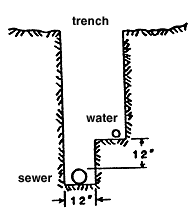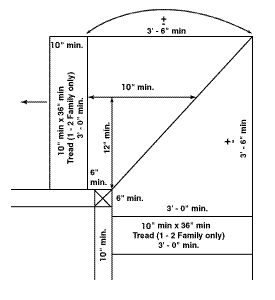- Asbestos - The removal or repair of over 3 linear or 3 square feet of asbestos containing material must be done by professionals, unless specifically exempt from DEP regulations. For more information on asbestos, contact the DEP Asbestos Hazard Prevention Program at 287-2651.
- Chimney - All chimneys must be built to the latest edition of NFPA 211 Standards for Chimneys, Fireplaces, Vents, and Solid Fuel Burning Appliances. They shall have a 2" clearance from all combustible material. One inch for exterior chimneys. State law, specifically, 32 MRSA, Chapter 33, requires chimney or fireplace installers to provide the homeowner with a disclosure prior to the installation work being done on a chimney or fireplace. Metal type chimneys may not be used for solid fuel application.
- Dept of Environmental Protection - DEP permits are required for any soil disturbance within 100 ft of any water body or wetland – Department of Environmental Protection.
- Egress Windows - The sill height shall not be more than 44" from finished floor level. Net clear opening of the bottom sash if it is a push up type, shall be no less than 5.7 sq ft with a minimum width of 20" and minimum height of 24". Removable or "tilt-out" sash are not exempt if the lower sash does not meet the area requirement above.
- Fire Separation - Fire separation wall between a garage and a residential use shall be on the garage side, 1/2" gypsum with all seams taped and all penetrations sealed. The entrance door shall have a 20 minute fire resistance rating. If the garage is located beneath habitable space, it shall be separated with floor and wall assemblies of not less than 1 hour fire resistance rating. Doors must have a 45 minute resistance rating stamped on the assembly (the assembly includes the frame). If a door in the garage leads to a lower level, that door must close automatically.
- Flood Elevations - Any construction or reconstruction around lakes, rivers, or streams may require a "Flood Elevation Survey".
- Garage Floor - When connected to a residential use, the garage floor shall be 4" lower than the entrance to the residence. To minimize the danger from explosive vapors, a self closing door is required on any garage door that leads to a lower level (i.e. basement).
- Lead - Lead may be present in the paint of any building built or remodeled before 1978. Sanding or scraping lead paint may cause a health hazard and steps should be taken to reduce lead exposure. For more information on lead, contact the DEP Lead Hazard Prevention Program at 287-7751.
-
Notches & Holes in Framing - Notch depth in the top or bottom of the joist, rafters and beams shall not exceed one-sixth the depth of the members and shall not be located in the middle one-third of the span. Notch depth at the ends of the member shall not exceed one-fourth the depth of the member. The tension side of beams, joists and rafters of 4" or greater nominal thickness shall not be notched, except at ends of members. Holes bored or cut into joists for piping or cables shall not be closer than 2" to the top or bottom of the joist and the diameter of the hole shall not exceed one-third the depth of the joist. In studs of bearing walls or partitions, notches or bored holes made to receive piping, electrical conduit, air conditioning or heating ductwork or for other fabricating purposes shall not be cut or bored more than one-third the depth of the stud.
NOTE: this standard does not pertain to engineered products (truss joist). Consult manufacturer's specifications for hole size and placement. - Railings and Guards – Guards must be at least 36" in height and the balusters shall be placed so that no space is larger than 4". Guards are required for any deck that is more than 15 1/2" above ground. Guards shall be a minimum of 42" for commercial use.
- Setbacks - It is the responsibility of the homeowner to check setback requirements for the zone that the property is in. The front setback is measured from the property line, NOT the edge of the road. A survey may be required to establish where the lot lines are located if it is going to be close.
- Sewer and Water Pipes - Building sewer or drainage piping shall not be run or laid in the same trench with water pipes or any underground water pipes unless both of the following requirements are met:
The bottom of the water piping at all points shall be at least twelve (12) inches above the top of the sewer piping.
The water piping shall rest on a solid shelf at one side of the common trench.

- Signs - All signage must be placed on premises. Please check sign ordinance prior to placing any signs.
- Site Stablization - erosion control measures must be in place to prevent erosion of soil or sediment beyond the project site or into a protected natural resource. These measures must be in place before any soil disturbance begins and remain in place until the site is permanently stabilized. (Stormwater Management & Erosion Control legislation effective July 1, 1997). No foundation inspection until the site is stabilized.
- Smoke Detectors - Shall be a "hard wired" system with battery back-up and located within 10' of any sleeping area, inside each sleeping area, and on each floor level including basements (in each space/room within the basement). (NFPA 101 1994)
- Stairways - Minimum width shall be 36 inches wide finished wall to wall. Treads and risers shall be as follows:
Residential maximum riser: 7 3/4 inches, 10 inch minimum tread as measured on the stair point. Nosing/overhang 1" maximum.
Commercial maximum riser: 7 inches, 11 inch minimum tread
- Winders - Shall not be permitted in required exit stairways except in Use Group R-3 and stairways serving a single dwelling unit and in ornamental stairways not required as an element of an exit. Such winders shall have a tread depth of not less than 10 inches at a point not more than 12 inches from the side where the tread is narrower and the minimum tread depth shall not be less than 6 inches.

Your winders must meet the written text of BOCA 1987 section 816.4.3/CABO 1983 section R214.2
- Vents - Should be installed in crawl spaces, attics and on dryers. Bathroom ceiling vents, when used, shall be vented to outside air, not into the soffit vents.
